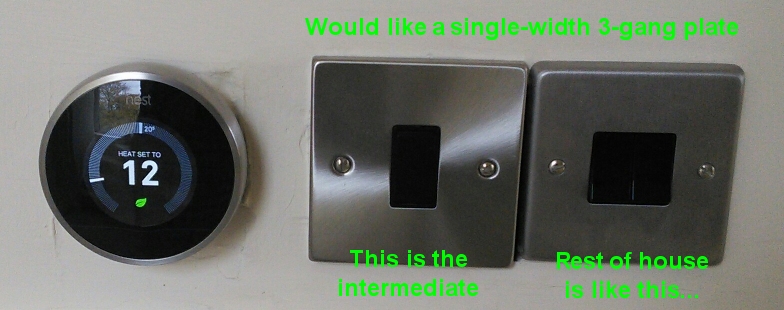In my house, bought earlier this year, I have a first floor landing light.
This first floor landing light can be turned on and off on the first floor landing, the ground floor and the second floor, so 3 places in total.
I have a style of switch faceplates throughout the house that is consistent, all apart from the first floor landing light switch that is on the first floor. That single switch is a different style to the switches throughout the house, including the other switches for this first floor light that are on the ground floor and second floor - they are also the same as the rest of the house.
I would like to change the first floor switch to be the same style at the rest of the house. I thought the previous owner had just failed to find the same style or had been lazy... but now I'm thinking it might be 'cos it needs to be an intermediate switch and an appropriate same style switch just could not be obtained.
If the first floor light is controlled from 3 floors, would there not need to be this special intermediate switch on the ground floor, first floor and second floor?
Or is an intermediate switch not really required on any floor?
I was speaking to an Electrician about taking on the job for me the other day and he did not seem to have any concerns... I told him I could get the same style switch and he said nothing about me needing a special intermediate switch at all, even though I'd described the layout just as I have here. This makes me wonder whether he would not be able to do the job on the day if I had bought a 2-way switch of the same style, or whether my concern about needing an intermediate switch is baseless.
Also... it got me wondering about doing it myself! Eek! I can turn the lights off at the circuit board, I can test for power with a funky screwdriver, I can take a photo of the wiring as-is and I can emulate that (hopefully).
Any advice on this would be greatly appreciated.
This first floor landing light can be turned on and off on the first floor landing, the ground floor and the second floor, so 3 places in total.
I have a style of switch faceplates throughout the house that is consistent, all apart from the first floor landing light switch that is on the first floor. That single switch is a different style to the switches throughout the house, including the other switches for this first floor light that are on the ground floor and second floor - they are also the same as the rest of the house.
I would like to change the first floor switch to be the same style at the rest of the house. I thought the previous owner had just failed to find the same style or had been lazy... but now I'm thinking it might be 'cos it needs to be an intermediate switch and an appropriate same style switch just could not be obtained.
If the first floor light is controlled from 3 floors, would there not need to be this special intermediate switch on the ground floor, first floor and second floor?
Or is an intermediate switch not really required on any floor?
I was speaking to an Electrician about taking on the job for me the other day and he did not seem to have any concerns... I told him I could get the same style switch and he said nothing about me needing a special intermediate switch at all, even though I'd described the layout just as I have here. This makes me wonder whether he would not be able to do the job on the day if I had bought a 2-way switch of the same style, or whether my concern about needing an intermediate switch is baseless.
Also... it got me wondering about doing it myself! Eek! I can turn the lights off at the circuit board, I can test for power with a funky screwdriver, I can take a photo of the wiring as-is and I can emulate that (hopefully).
Any advice on this would be greatly appreciated.


